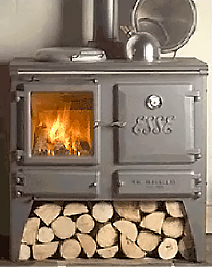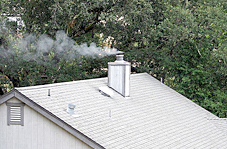This information pertains to statewide residential fireplaces and solid fuel burning devices, including fireplaces and wood, pellet, and coal burning stoves.
Residential fireplaces and solid fuel burning devices contribute particulate matter emissions to the atmosphere. To minimize the amount of emissions from these devices, they are regulated by a visible emission standard (opacity). When operated properly, these devices will produce visible emissions of less than 20% opacity from the chimney or smoke stack.
The proper operation of these devices is required to meet the visible emission standard of 20% opacity during normal operation. The 20% opacity limit applies at all times except for an initial start-up period of 15 minutes and a 15 minute period in any three hour period for reloading the device.
Opacity is a measurement of how much visibility is obscured by a plume of smoke. For example, if a plume of smoke from a chimney or smoke stack obscures 20% of the view in the background, the visible emissions from the smoke plume is 20% opacity. For more information on how visible emissions are measured, visit the the EPA’s Technology Transfer Network Emission Measurement Center site.
There are additional restrictions on solid fuel burning devices for Cache, Box Elder, Weber, Davis, Salt Lake, Tooele, or Utah Counties.
Regulations for Solid Fuel Burning Devices
These regulations cover Box Elder, Cache, Davis, Salt Lake, Tooele, Utah, and Weber Counties and include fireplaces and wood, pellet, and coal burning stoves.
Winter inversions trap microscopic particles called PM2.5 in the air. The use of solid fuel burning devices, such as fireplaces wood, pellet, and coal burning stoves contributes PM2.5 emissions to the atmosphere. Winter inversions cannot be controlled, so PM2.5 emissions must be reduced during inversion periods to meet National Ambient Air Quality Standards (NAAQS).
The Division of Air Quality operates air monitoring equipment to measure the concentration of PM2.5 in the atmosphere. This information, with weather forecasting and computer modeling is used to determine the action level for solid fuel burning devices. The following chart explains the three action levels.
Wood Burn Action Level
Unrestricted Action
Wood, pellet and coal burning stoves and fireplaces may be used but please use them in a proper manner to reduce smoke emissions.
Voluntary Action
Voluntarily do not use wood, pellet, coal burning stoves or fireplaces. Reduce vehicle use by consolidating trips. Industry should optimize operations to minimize air pollution emissions.
Mandatory Action
Wood, pellet and coal burning stoves or fireplaces must not be used. Reduce vehicle use by consolidating trips. Industry should optimize operating conditions to minimize air pollution emissions.
The three action levels affect all residents living in the following areas:
- All regions of Salt Lake and Davis counties.
- All portions of the Cache Valley.
- All regions in Weber and Utah counties west of the Wasatch mountain range.
- In Box Elder County, from the Wasatch mountain range west to the Promontory mountain range and south of Portage.
- In Tooele County, from the northernmost part of the Oquirrh mountain range to the northern most part of the Stansbury mountain range and north of Route 199.
The current action level is reported twice daily to local media outlets (newspapers, TV, and radio stations). You can also find the action level on our Website and register to receive Email air quality alerts:
Contact
To contact the Utah Division of Air Quality with questions or complaints:
- Call (801) 536-4000
Or visit:
- Division of Air Quality
General air quality information. - Regulations for Solid Fuel Burning Devices
Regulations for Cache, Box Elder, Weber, Davis, Salt Lake, Tooele, or Utah counties. - Technology Transfer Network Emission Measurement Center
Information on measuring visible emissions.


